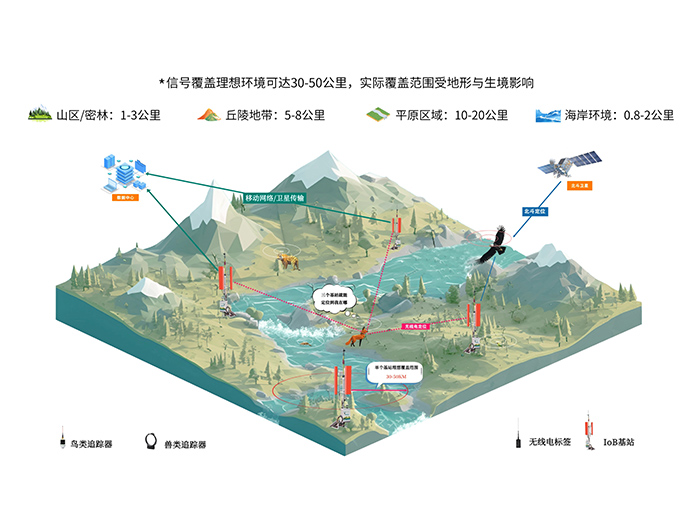事实上,鸟类的迁徙不仅仅关乎生态保护,也密切关联着我们的日常生活。频繁暴发的禽流感疫情提醒我们,鸟类的迁徙路径和病毒传播紧密相关,掌握迁徙规律能帮助我们更有效地防控疫情。同时,航空飞行区域与鸟类迁徙路线的重叠,掌握鸟类飞行通道也为飞行安全提供了重要保障。
尽管人类一直试图解开鸟类迁徙之谜,但受限于技术瓶颈,特别是对体型较小的鸟类,我们过去很难实现精准的高频率数据监测,研究成果也相对碎片化。

IoB追踪器重量最轻仅0.35克,2.3g的追踪器可实现日均采集1440个高精度位置信息,细致记录鸟类每秒的行为变化,让科研人员首次清晰观察到迁徙过程中的每一个细节。
此外,IoB智能基站其信号覆盖范围最远可达30公里,并采用自动“打卡”技术。当佩戴追踪器的鸟类进入IoB监测范围时,系统即可自动记录鸟类的准确到达和离开时间。基站之间通过自组网技术互相联通,即便在偏远地区,也能确保数据无缝传输与共享,大幅降低了人工监测成本。
环球信士计划:
2025年,将在东亚-澳大利西亚迁飞通道以及中国东部沿海地区部署20台基站,初步建立起区域性监测网络。
2026年,继续在长江、黄河流域新增50台基站,全面监测国内重要候鸟停歇地。
此后,还计划逐步拓展至俄罗斯、东南亚、澳大利亚等国际重要迁徙通道,最终形成全球性的鸟类迁徙生态监测网络。
Global Messenger's IoB Networked Monitoring System:Making Avian Migration No Longer a Mystery
Twice each year,countless migratory birds traverse mountain ranges and rivers,cross vast seas,and undertake an arduous journey.How do they reliably navigate these routes?And how do fledglings learn this life-saving path from their parents?These questions captivate our imagination—and they reshape how we understand shifts in the ecological landscape.
Bird migration matters not only for conservation but also for our everyday lives.Recurrent outbreaks of avian influenza underscore how closely migratory pathways intertwine with virus transmission.By mapping these routes,we can more effectively predict,control,and prevent future epidemics.Meanwhile,the overlap between aviation corridors and avian flyways makes insight into bird movements essential for ensuring flight safety.
Despite centuries of inquiry,technological limits have left our data on bird migration sparse and fragmented—particularly for smaller species.To overcome this challenge,Global Messenger has developed the Internet of Biology(IoB)Networked Monitoring System.This cutting-edge platform combines ultra-lightweight trackers,intelligent communication base stations,and a cloud-based data hub to deliver precise,high-frequency monitoring of avian movements.
Weighing as little as 0.35g—and with a 2.3g version capable of capturing up to 1,440 high-precision locations per day—the IoB tracker logs behavioral changes every second.For the first time,researchers can scrutinize every detail of a bird’s migration.In ideal conditions,each base station’s signal can reach up to 30 km,and its automatic“check-in”technology records the exact arrival and departure times of tagged birds.Self-organizing network protocols interconnect stations,enabling seamless data flow—even in remote regions—and drastically reducing manual monitoring costs.
Global Messenger’s Deployment Plan
2025:Deploy 20 base stations along the East Asian–Australasian Flyway and China’s eastern coast to establish an initial regional network.
2026:Install 50 more stations across the Yangtze and Yellow River basins to monitor the nation’s key migratory stopover sites comprehensively.
Beyond:Expand into other international corridors—through Russia,Southeast Asia,and Australia—with the ultimate goal of creating a truly global avian migration monitoring network.





